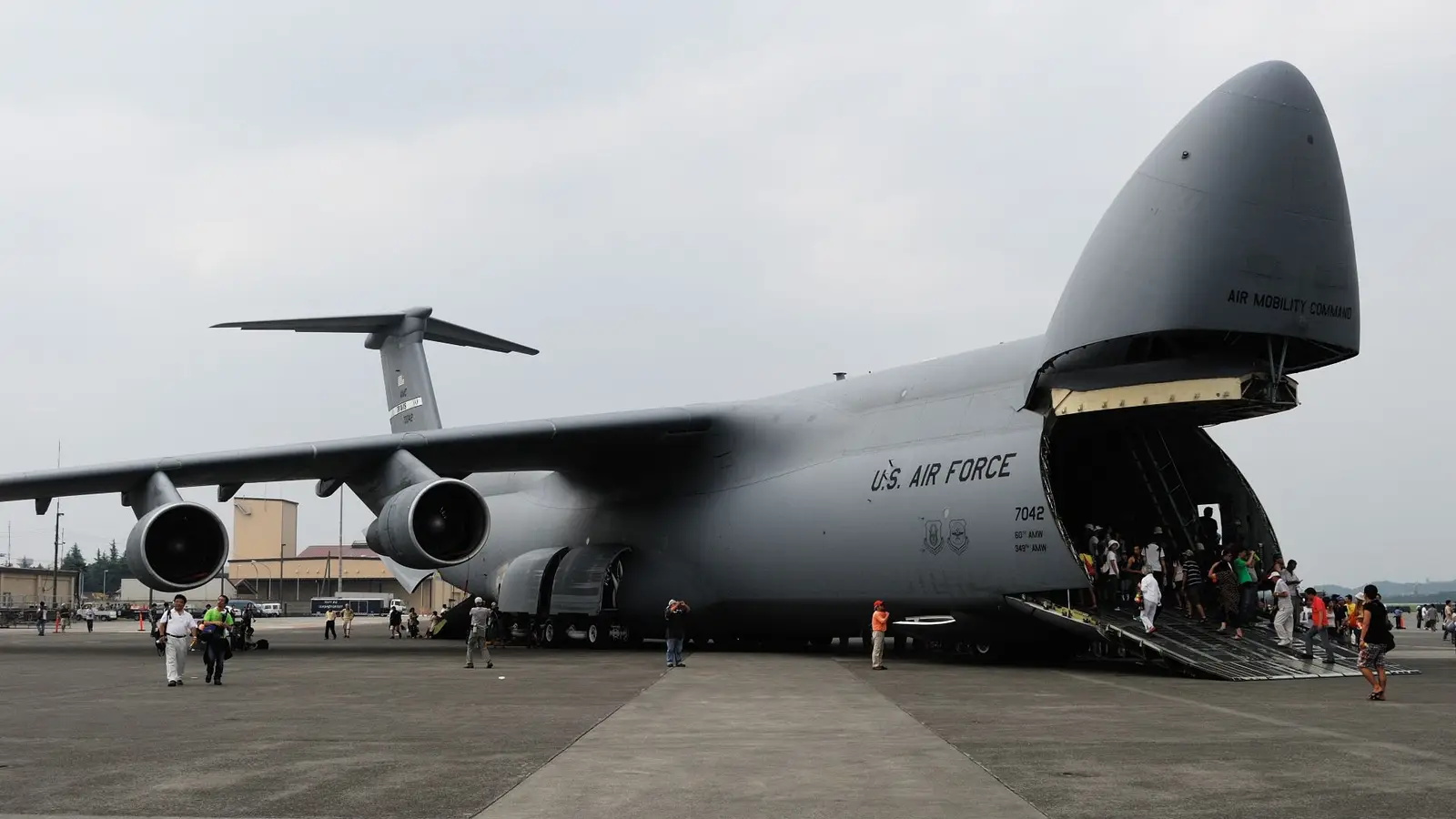
The Boeing 747 and Lockheed C-5 Galaxy were the world’s first widebodies. The C-5 took its first flight slightly over seven months before the 747 in June 1968, while the 747 entered service five months before the C-5 Galaxy in January 1970. Although the C-5 Galaxy doesn’t have two passenger aisles (as it’s designed to carry cargo), it is a widebody in every other sense of the word, and these two aircraft remain among the largest in the entire world.
Despite their different roles, these two giants have a number of distinct similarities. Perhaps most distinctly, both aircraft feature a second deck that primarily houses the cockpit, along with a small passenger cabin behind it. Both aircraft are quadjets and were also the first planes to use high-bypass turbofan engines. Additionally, elements of the 747’s design were derived from Boeing’s submission to the contest that ultimately led to the creation of the C-5 Galaxy.
The Origin Of The 747 And The C-5
The USAF formally issued a Request for Proposal (RFP) in 1964 for a large cargo aircraft significantly larger and more capable than the Lockheed C-141 Starlifter. Titled, “CX-HLS” (Heavy Lift System), the competition was narrowed down to Boeing, Lockheed, and McDonnell Douglas, with the C-5 coming out the victor. Additionally, General Electric was chosen to develop the TF39, the world’s first high-bypass turbofan.
Elements of Boeing’s submission for the CX-HLS were used to design the 747; however, the concept for the 747 as a whole came from a request by Pan American World Airways President Juan Trippe. Trippe desired an aircraft more than twice the size of the Boeing 747 with unrivaled per-seat costs. Given that his demands would come with a purchase for 25 units, Boeing committed. As it turns out, the type became incredibly popular, and Boeing sold 1,573 747s across 55 years of continuous production.
The 747 was primarily sold as a passenger airliner, whereas the C-5 Galaxy was designed for cargo transport. However, common sentiment in the 1960s was that supersonic transports would eclipse subsonic airliners, and so the 747 was designed to function as well as a cargo aircraft. The key component to this was the nose cargo door, which was made possible by the upper deck cockpit and was first seen on Boeing’s CX-HLS proposal.
Looking At The Variants Of The 747 And The C-5
The Boeing 747 was produced in several variants across its over five-decade production history. However, most of these models were largely the same size. Boeing first altered the aircraft’s length with the 747SP, but this was in an effort to make the aircraft shorter and reduce its empty weight as Boeing sought to improve its range. The 747-100 and 747-200 had identical lengths and wingspans, whereas the 747-300 and 747-400 featured a longer upper deck. The 747-400 also introduced winglets.
The 747-8 was the final variant of the 747 and was also the first to incorporate a fuselage stretch. Boeing added plugs in front and behind the wings, while also stretching the upper deck even further to create what remains the longest passenger airliner currently in service. Additionally, the 747-8 came with a reprofiled wing that was enlarged, along with a significant bump in Maximum Takeoff Weight (MTOW) and new General Electric GEnx engines.
The C-5 Galaxy has also been produced in different models. However, all C-5 variants are the same size, with differences primarily coming from design upgrades, technology, and capabilities. The C-5M Super Galaxy is the most recent C-5 variant, and it is also the most significant revamp to the aircraft yet. Of course, the refresh includes a cockpit upgrade and modernized avionics, but the most prominent change is the new General Electric F138 engines (the military variant of the CF6-80).
Which One Is The Larger Aircraft
The Boeing 747SP is a shrink of the 747-200 and is closer in size to a Boeing 787-8. The 747-100, 747-200, 747-300, and 747-400 all retain the same fuselage length of 231 feet, 10 inches (70.7 meters), and the 747-100/747-200/747-300 have a wingspan of 195 feet, eight inches (59.6 meters). The 747-400’s canted winglets expand the 747’s winglets to 211 feet, five inches (64.4 meters). The 747-400 also has an MTOW of 396.9T in its standard iteration and 412.8T as the 747-400ER.
The Boeing 747-8 was the most thorough overhaul of the 747. The 747-8, sold as the cargo-only 747-8F and as the passenger 747-8i, included a fuselage stretch, new engines, technological updates, and a reprofiled wing. The length was elongated to 250 feet, two inches (76.25 meters), making it the longest airliner currently in service, and the wingspan was widened to 224 feet, seven inches (68.5 meters). The MTOW, meanwhile, was bumped to 447.7T.
The C-5 Galaxy was built with a length of 247 feet, one inch (75.31 meters) along with a wingspan of 222 feet, nine inches (67.89 meters), while its MTOW is 381T. As such, the C-5 Galaxy is most comparable to the 747-8 variant rather than earlier models, making it undeniably the largest aircraft of its day. Even today, the C-5 Galaxy dwarves almost all widebody aircraft in service, so you can imagine the reactions of observers in 1968, especially considering that the C-5 took flight before the 747.
How The Size Of The C-5 Galaxy Defines Its Role
The 747-8 is slightly longer with a wider wingspan and is rated for a significantly higher MTOW than the C-5 Galaxy. However, the C-5’s tail is taller, and the aircraft’s fuselage is comparable to the 747-8. Additionally, despite the C-5 having a marginally smaller wingspan, its wing area is actually higher than that of the 747-8, as the C-5’s wing area measures at 6,200 square feet (580 meters). The 747-8’s wing area is 5,960 square feet (554 square meters).
The result is that this is essentially the second-largest conventional aircraft currently in service (after the Airbus A380). Size was the point of the C-5 Galaxy, and the United States Air Force uses the C-5 to do what no other aircraft can do. With its MTOW of 381T, its range is limited compared to a 747, but it can easily outlift any aircraft in the Air Force’s fleet, and its range is still excellent when compared to the rest of the USAF’s fleet.
The C-5 has incredible lifting capability and has an enormous cargo hold. In a practical sense, the C-5 can perform missions such as transporting two or three Chinook helicopters simultaneously or flying two M1 Abrams tanks. Additionally, C-5s often transport vehicles for the Presidential motorcade when the President of the United States travels, which lowers costs and reduces disruptions since fewer aircraft are needed.
How The Boeing 747’s Size Killed It
The Boeing 747 is one of the most successful widebody aircraft programs of all time, having sold 1,573 examples across its five decades in production. However, while the purpose of the 747 program was to create the world’s largest airliner in an effort to lower per-seat costs, this was not the main reason for its success. Instead, the 747 came with an unparalleled range that allowed airlines to open up new markets at an unprecedented rate, which was perhaps most noticeable with the 747-400.
However, as time passed, smaller aircraft became more capable. The Airbus A340, Boeing 777-200ER, and McDonnell Douglas MD-11 were the first aircraft to come close to the 747’s range in the 1990s, but it was the 777-300ER that truly replaced the 747-400 in the marketplace. It was smaller than the 747-400, but close enough that it could still serve as an effective flagship for many airlines, and it was significantly more efficient due to having just two engines.
Larger planes are riskier for airlines to operate, so the Boeing 777-300ER, being slightly smaller and far more cost-effective, quickly became one of the most popular aircraft models in the widebody market. Boeing sold 422 777-200ERs and 694 747-400s, but it sold well over 800 777-300ERs, making it by far the most popular variant of the 777 and more successful than any 747 variant. The 747-8, in comparison, only sold 155 units, most of which were for the freighter version.
Rundown Of The C-5 And The 747
The Lockheed C-5 Galaxy remains one of the largest production aircraft to have ever flown, but whereas the 747’s size has become a hindrance, the C-5’s immense size is what makes it an integral part of the USAF’s fleet. No other military aircraft can do what it does, and even today, its lifting capabilities are matched by few other aircraft.



